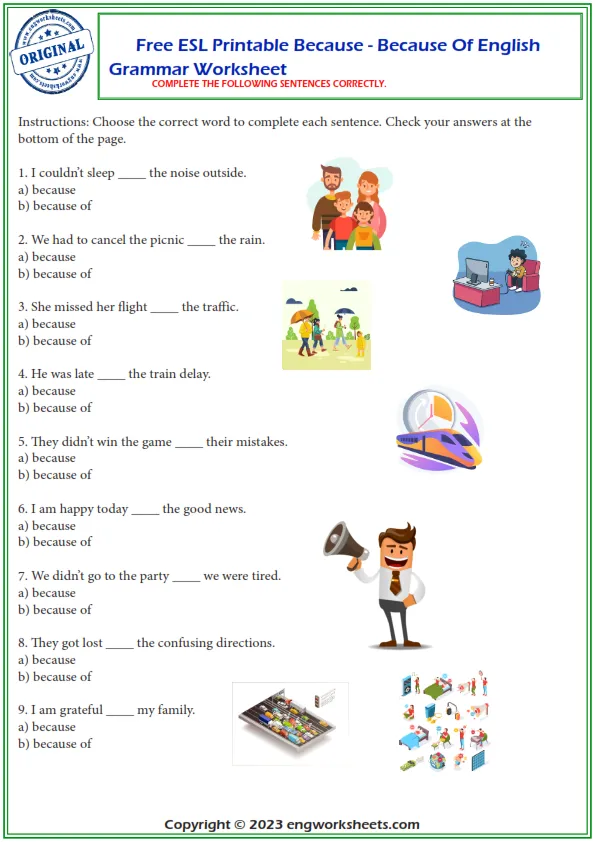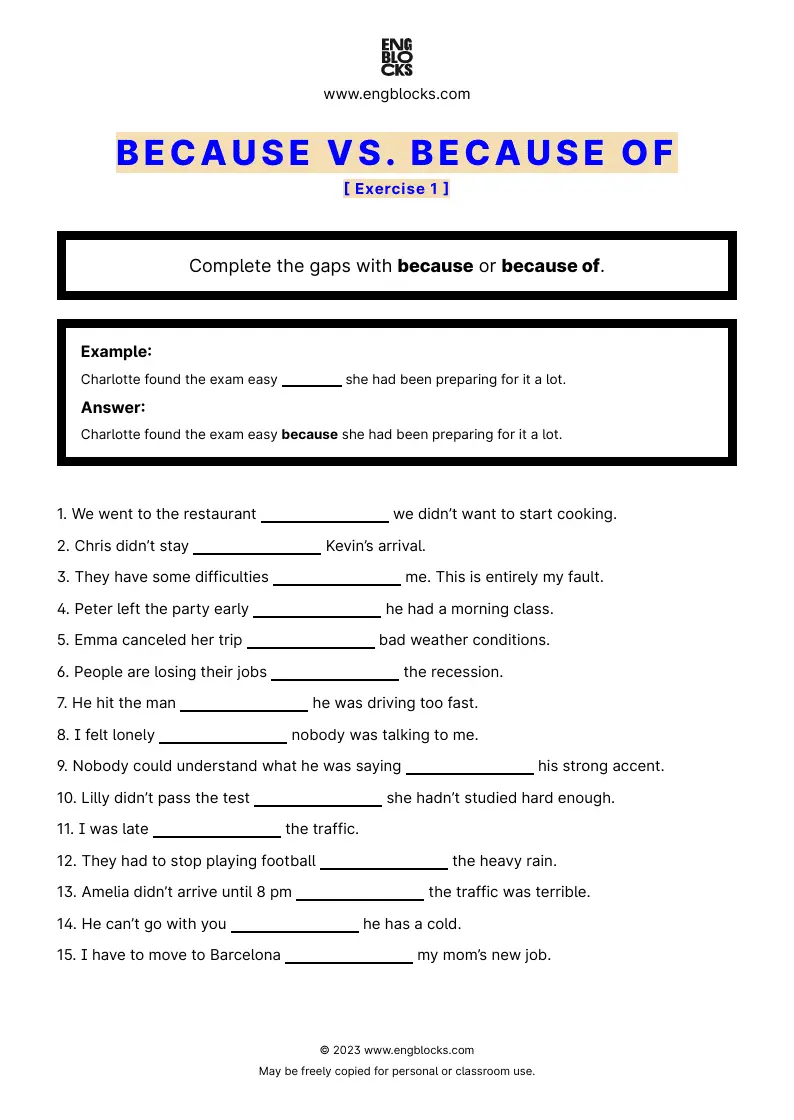
Unlocking Cause and Effect: The Power of Grammar Worksheets: Because/Because Of
Understanding cause and effect is fundamental to clear communication. Whether we’re explaining why something happened, justifying a decision, or simply narrating events, the ability to articulate these relationships is paramount. However, mastering the linguistic tools to express these connections, particularly with the subtly distinct "because" and "because of," often poses a significant hurdle for English learners. This is where dedicated Grammar Worksheets: Because/Because Of become invaluable, serving as a structured pathway to internalize these crucial grammatical distinctions and apply them with confidence.
The English language offers various ways to express causality, but "because" and "because of" are among the most common and, paradoxically, the most frequently confused. While they both convey the idea of a reason or cause, their grammatical functions are entirely different, demanding different sentence structures. Misusing them can lead to awkward phrasing, grammatical errors, and even miscommunication.
Decoding "Because": The Subordinating Conjunction

Let’s first delve into "because." This word functions as a subordinating conjunction. Its primary role is to connect a dependent clause (which contains a subject and a verb but cannot stand alone as a complete sentence) to an independent clause (a complete sentence). The dependent clause introduced by "because" provides the reason or cause for the action or state described in the independent clause.

Structure: Independent Clause + because + Dependent Clause (Subject + Verb)

OR

Because + Dependent Clause (Subject + Verb), + Independent Clause

Examples:
- She succeeded because she worked incredibly hard. (Independent clause: She succeeded; Dependent clause: she worked incredibly hard)
- The flight was delayed because there was a severe thunderstorm. (Independent clause: The flight was delayed; Dependent clause: there was a severe thunderstorm)
- Because he was feeling unwell, he decided to stay home. (Dependent clause first, followed by a comma)
- They celebrated their victory because they had trained tirelessly for months.


Notice how in each example, the phrase following "because" always contains both a subject (she, there, he, they) and a verb (worked, was, was feeling, had trained). This is the defining characteristic of a clause.
Common errors with "because" often involve treating it like a preposition and following it with a noun phrase, which is incorrect. For instance, saying "He was late because the traffic" is grammatically wrong.

Decoding "Because Of": The Prepositional Phrase
In contrast, "because of" functions as a prepositional phrase. It introduces a noun phrase, a pronoun, or a gerund (a verb ending in -ing used as a noun) that acts as the reason or cause. Unlike "because," "because of" does not introduce a full clause with a subject and a verb.

Structure: Independent Clause + because of + Noun/Pronoun/Gerund Phrase
OR
Because of + Noun/Pronoun/Gerund Phrase, + Independent Clause
Examples:
- She succeeded because of her incredible hard work. (Noun phrase: her incredible hard work)
- The flight was delayed because of the severe thunderstorm. (Noun phrase: the severe thunderstorm)
- Because of feeling unwell, he decided to stay home. (Gerund phrase: feeling unwell)
- They celebrated their victory because of their tireless training. (Noun phrase: their tireless training)
- He couldn’t attend the meeting because of him. (Pronoun: him)
Here, the words following "because of" are always nouns, pronouns, or gerunds, or phrases built around them. They never form a complete clause with a subject and a conjugated verb.
Common errors with "because of" include attempting to follow it with a full clause. For example, "He was late because of he missed the bus" is incorrect; it should be "He was late because he missed the bus."
The Common Pitfall: Why the Confusion?
The core of the confusion lies in their semantic overlap. Both phrases convey cause. The difficulty arises from their syntactic divergence. Learners often grasp the meaning but struggle with the precise grammatical structure required for each. For instance, consider these two grammatically correct sentences that convey a very similar idea:
- "The picnic was cancelled because it rained." (Clause: it rained)
- "The picnic was cancelled because of the rain." (Noun phrase: the rain)
The ability to fluidly switch between these constructions, understanding when to use a clause and when to use a noun phrase, is a hallmark of advanced English proficiency. This is precisely why Grammar Worksheets: Because/Because Of are not just helpful, but truly indispensable.
The Indispensable Role of Grammar Worksheets
Grammar Worksheets: Because/Because Of offer a controlled environment for learners to practice and internalize these distinctions. They provide the repetitive exposure necessary to move from conscious rule application to automatic, intuitive usage. Here’s how they contribute to mastery:
- Targeted Practice: Unlike general grammar exercises, dedicated worksheets isolate the "because/because of" distinction, forcing learners to focus solely on this specific challenge. This targeted approach prevents cognitive overload and allows for deep learning.
- Pattern Recognition: Through repeated exposure to various sentence structures and contexts, learners begin to recognize the patterns associated with each phrase. They start to instinctively look for a subject-verb combination after "because" and a noun/gerund after "because of."
- Error Identification and Correction: Worksheets often include exercises where learners must identify and correct errors. This active process of finding mistakes helps solidify their understanding of the rules and makes them more aware of their own potential errors in future communication.
- Confidence Building: Successfully completing exercises, especially those with answer keys for self-correction, boosts a learner’s confidence. This positive reinforcement encourages further practice and reduces anxiety about making mistakes in real-world conversations or writing.
- Variety of Exercise Types: Effective Grammar Worksheets: Because/Because Of don’t just rely on one type of exercise. They incorporate:
- Fill-in-the-blanks: Learners choose between "because" or "because of" to complete sentences, based on the following structure.
- Sentence Transformation: Learners rewrite sentences, changing "because" constructions to "because of" constructions (and vice versa), which deeply tests their understanding of the structural differences.
- Error Correction: Learners identify and fix incorrect usages in given sentences.
- Multiple Choice: Learners select the correct option from a set of choices.
- Sentence Combining/Creation: Learners combine simple sentences using the target structures or create their own sentences based on given prompts. This encourages active production rather than just recognition.
Crafting Effective Grammar Worksheets: Because/Because Of
For educators and learners creating their own practice materials, certain principles can maximize the effectiveness of these worksheets:
- Clear Instructions: Ensure that the instructions for each exercise are unambiguous and easy to understand.
- Gradual Difficulty: Start with simpler, more straightforward sentences and gradually introduce more complex scenarios or vocabulary. This scaffolding approach prevents learners from feeling overwhelmed.
- Contextualized Sentences: Avoid isolated, abstract sentences. Instead, use sentences that are part of a mini-dialogue, a short paragraph, or describe a relatable situation. This helps learners see the practical application of the grammar.
- Example (poor): He was tired ____ the long journey.
- Example (better): Sarah missed the bus this morning. She was late for work she overslept. She apologized to her boss, explaining that her alarm clock didn’t go off a power outage during the night.
- Incorporate Common Errors: Design exercises that specifically target the common mistakes learners make, such as following "because" with a noun phrase or "because of" with a clause.
- Provide Answer Keys: For self-study, an answer key is crucial. It allows learners to check their work immediately, understand their mistakes, and learn from them.
- Encourage Self-Correction and Reflection: Beyond just checking answers, prompt learners to think about why an answer is correct or incorrect. "Why did you choose ‘because’ here?" or "What grammatical element follows ‘because of’ in this sentence?"
Beyond the Worksheet: Application and Reinforcement
While Grammar Worksheets: Because/Because Of are powerful tools, they are not an end in themselves. Their ultimate purpose is to equip learners with the ability to use these structures accurately and naturally in real-world communication. Therefore, the learning process should extend beyond the worksheet:
- Active Application in Speaking: Encourage learners to consciously use "because" and "because of" when explaining reasons in conversations. Role-plays, debates, and simple Q&A sessions can provide opportunities.
- Application in Writing: Assign writing tasks that require learners to explain causes and effects. This could be anything from a personal journal entry explaining why they like a hobby to a more formal essay analyzing the causes of a historical event.
- Extensive Reading: Exposing oneself to a wide range of authentic English materials (books, articles, news) helps learners see "because" and "because of" used in natural contexts. This passive learning reinforces the patterns they’ve practiced.
- Feedback: Whether from a teacher, a tutor, or a language exchange partner, receiving constructive feedback on their usage in spoken and written English is invaluable.
Ultimately, the goal of using Grammar Worksheets: Because/Because Of is to internalize these rules so deeply that their application becomes second nature. It’s about building muscle memory for the brain, allowing learners to focus on the message they want to convey rather than struggling with the underlying grammar.
Conclusion
The distinction between "because" and "because of" is a classic example of how subtle grammatical differences can have significant implications for clarity and correctness in English. For English language learners, mastering this distinction is a crucial step towards achieving fluency and precision. Grammar Worksheets: Because/Because Of provide the structured, repetitive, and targeted practice necessary to navigate this common grammatical challenge. By diligently engaging with these resources, understanding their design principles, and extending the learning into real-world application, learners can transform a tricky grammatical distinction into a confident linguistic asset, empowering them to explain the world around them with greater accuracy and eloquence.
